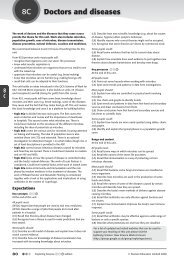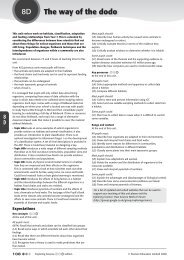8E TEACHER GUIDE.pdf - swallowhillresources
8E TEACHER GUIDE.pdf - swallowhillresources
8E TEACHER GUIDE.pdf - swallowhillresources
- No tags were found...
Create successful ePaper yourself
Turn your PDF publications into a flip-book with our unique Google optimized e-Paper software.
<strong>8E</strong>aUsing water<strong>8E</strong>aExploring tasks1: Pupil’s Book page 63 (AT)This page introduces the idea that we have a plentiful supply ofclean, safe water in the UK, but that people in other countries arenot always so fortunate. The questions should help pupils to reviseearlier work on the water cycle and filtering.• The AT video link opens Water companies – a clip showing TinaDijkstal from Southern Water talking about how she became ahydrogeologist and what she does. She also gives some examplesof how much water is used and how much the company supplies.• The AT spreadsheet link opens Using water – a spreadsheet tohelp pupils to calculate how much water their household usesand to draw pie charts showing the volumes used for differentuses. You could follow this up by asking pupils to estimate usagesfor families in different circumstances (e.g. more young children,an elderly person living alone, etc).2: Practical: Soil filterThe Practical box on page 65 of the Pupil’s Book suggests that pupilsdesign a soil filter that could be used for survival in the countryside.• Must: pupils follow the instructions on Worksheet <strong>8E</strong>a(2) to buildtheir filter, and then complete the exercise at the bottom of thesheet to explain how it works.• Should: Worksheet <strong>8E</strong>a(3) provides brief instructions for theconstruction of the filter, and then asks pupils to investigate howfast their filter works.• Could: pupils could be asked to design their own filter based onlyon the prompt in the Pupil’s Book and/or materials provided, andasked to design their own investigation. They should evaluateeach other’s filters based on scientific tests to award one group/pupil with a ‘best design’ award. Do not allow pupils to drink their water. It could still becontaminated.Resources (per group)Plastic drinks bottle (bottom removed – ensure there are nosharp edges); moss or grass; ruler; small stones; sand (or soil);muddy/dirty water to filter (with bits of grass, twigs, etc.);stopclock; beakers; bucket to collect waste; Worksheets <strong>8E</strong>a(2)or <strong>8E</strong>a(3).3: Practical: Testing solubilityProvide pupils with a selection of solids and ask them to mixa spatula of each with water in a test tube or boiling tube. Themixture can be stirred with a spatula or glass rod. Pupils should beencouraged to use appropriate vocabulary to describe the resultingmixture, and then come to a judgement about whether the solid issoluble or insoluble.• Should: ask pupils to explain how they are making judgementsabout what is soluble and what is not.With some groups it may be appropriate to introduce additionalgradations such as ‘partially soluble’, ‘mostly soluble’, and so on.You could also include some liquids.• Could: a light meter could be used to measure the amount oflight coming through each test tube.Note that Exploring 1 in Topic <strong>8E</strong>b looks at solubility in a morequantitative manner. Aspirin can be harmful.Resources (per group)8 test tubes or boiling tubes; glass rods; spatulas.Suggested list of solids: sugar, salt, flour, instant coffee or tea,aspirin*, soap, pepper, baking soda.(*A brand such as Aspro Clear TM will dissolve completely.)4: Practical: Effectiveness of solventsPupils compare the effectiveness of solvents in removing differenttypes of marks. It is suggested that you keep a class set of ‘offcuts’for this practical – for example material from discarded worksurfaces, whiteboards or polished wood. A piece of the board(about 20 cm × 10 cm would be a suitable size) can be markedusing a variety of substances, for example ball point pen, washablemarker pen, permanent marker, wax crayon and liquid paper, andthe marks labelled. Pupils should be given the opportunity to seewhich of these can be removed easily with a damp cloth. For thosemarks that are not easily removed in this way, other solvents shouldbe tried, for example ‘meths’ (now called Industrial DenaturedAlcohol), white spirit or propanone (acetone). Industrial Denatured Alcohol is highly flammable and harmful.Propanone is an irritant and highly flammable. White spirit isharmful and flammable. Ensure there are no naked flames inthe lab. This practical should be carried out in a well-ventilatedlaboratory. Eye protection should be worn.Resources (per group)Wooden or work surface ‘offcuts’ (about 20 cm × 10 cm)marked with (at least three from) biro, marker pens, nail varnish,liquid paper, wax crayon; access to solvents (e.g. IndustrialDenatured Alcohol, propanone, white spirit); cloths; disposablegloves (preferably nitrile, not latex); eye protection.Explaining tasks1 Pupil’s Book pages 64–65 (AT)These pages look at mixtures, filtering and dissolving. Worksheet<strong>8E</strong>a(1) is the Access Sheet.• Must: read through the text with pupils and ask them to answerthe questions.• Should: pupils should remember most of this work from KS2.However, it is worth confirming this before moving on to the restof the unit. This can be done by giving pupils the top half of theAccess Sheet only, and asking them to write their own definitionsof the words. They should try this without reference to the book atfirst, but could then use the book to check their definitions.• The AT video link on page 64 opens Filtering water supplies – aclip showing Tina Dijkstal explaining how river water is filteredat the treatment works before being disinfected and fed into thewater supply.• The second AT presentation link on page 64 opens Ideas aboutmixtures and solutions – see Starter 3 and Plenary 2.• The AB document link on page 64 opens Other mixtures – seeExplaining 3.2: Practical: How to filterDemonstrate how to use filter paper and a funnel to filter in the lab.Let pupils practise this to produce clean water from pure water plusdirt or from salt solution plus dirt. The products from this processcould then be kept to use in the following topic.Resources (per group)Funnel; filter paper; beaker; conical flask; samples of dirty water.142Exploring Science edition © Pearson Education Limited 2008






